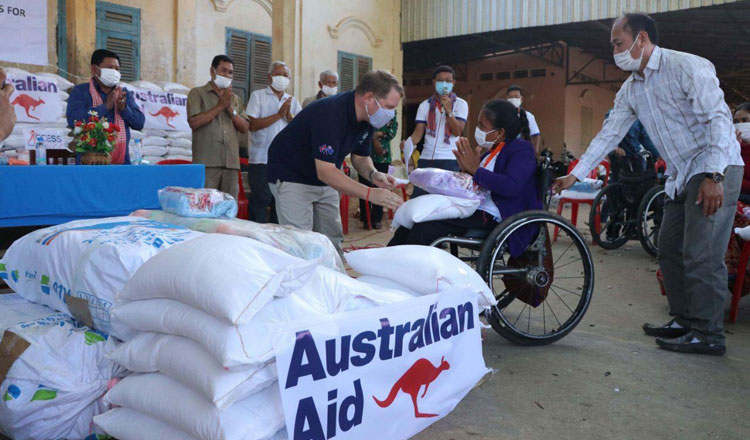Tea time for the Kingdom’s next generation of drinkers?
Containing around half of the amount of caffeine found in a cup of coffee, as well as natural antioxidant properties, multiple health benefits and a satisfying taste, tea is understandably the second most consumed beverage globally.
It is a huge market, with global tea imports totalling $5.7 billion in 2019 and production dominated by Asian countries.
It is also growing rapidly in Cambodia, with Tridge online reporting a year on year 122.9 percent average rise in green tea imports alone, at a cost of around $765,480.
Yet despite the huge market, increasing domestic popularity and a suitable climate, Cambodia produces very little tea of its own, with the website reporting total green tea export earnings in 2019 as raising a mere $3,670.
Tea time
After purportedly being first introduced by the Chinese during the Angkorian period, growth of the plant never took off and it wasn’t until the 1960s when King Father Norodom Sihanouk launched the only large scale tea production enterprise, after receiving tea plants from China.
The ambitious project initially spanned 24 hectares and was later even expanded. However, amid the turmoil of the Khmer Rouge regime in the 1970s, cultivation was interrupted again, only to continue under a private investor until 2000 when the owner reportedly died and cultivation on the plantation stopped.
However, the influx of tea-related drink shops such as Taiwanese Bubble Tea chain Chatime and more recently Hong Kong tea shop Heeretea are evidence of a new, growing demand for tea, especially among youths.
Srey Oun, a 21-year-old student, said she got into tea while at school.
“I really like iced green tea, but I don’t know where it comes from. I got into it when I was 16, as everyone would go to the tea shops after school. I think I would pick a tea if I knew it was Cambodian, especially if I knew it helped communities, but I wouldn’t know where to find it,” she said.
Change is brewing
Michie Nishiguchi, owner of tea brand Demeter, says the demand does offer an opportunity for Cambodian tea businesses, but the immediate issues must be addressed first.
“Currently, many shop owners here are just not eager to find unique Cambodian-made teas and instead use imported teas,” she said.
“The issue is that coffee production has large-scale investment and technical assistance from outside the country coupled with high domestic demand, which tea currently does not,” she said.
“The climate is not a problem as Kampong Speu, Mondulkiri and Ratanakiri are suitable locations to grow camellia tea plants and some people do grow it there. However it needs investment and assistance to compete,” she said.
However, the Demeter owner has capitalised on the growing tea market through herbal options with a Khmer influence.
“In Cambodia, you can find varieties of local herbal plants almost everywhere, therefore there is no need for a large financial injection to start making dry herbal tea.”
“Traditional herbal medicine or Krou Khmer has existed since the Angkor empire era and is associated with health and medicinal benefits. We are taking the essences and knowledge from this tradition and making herbal “healthy tea”, which is kind of a new concept for many Cambodians,” she said.
Demeter is also an example of how renewed tea cultivation can have a positive educational and local impact on communities.
Down to earth
“I partnered my business with farmers, community women’s groups and schools to reinvest in the community and we began the school herbal garden programme, which we now run with two schools in Siem Reap and eight in Koh Kong,” she said.
The project aims to benefit the schools threefold, she said. First, by teaching children about the environment. Second to produce and reconnect Cambodians with herbal tea medicine, with part of the profit from selling the herbs also reinvested in the schools to help with operational costs.
“We are also starting the “School Health Room” project in Koh Kong province in collaboration with the provincial education office to establish a care service for sick students, while also teaching hygiene for the benefit of the local community,” she said.
Also flying the flag for Cambodian tea is brand Kirum, which has taken the world renowned Kampot Pepper and infused it into a range of herbal teas grown in the Kingdom to create a truly Cambodian product.
Parent company Confriel, recognised by the Asian Development Bank and the World Bank as a business model for sustainable development, strives to demonstrate that improving farmer incomes depends on the creation, in Cambodia, of high value-added products grown in local soils.
The tea produce also offers a range of benefits for consumers.
Indeed, tea is recommended as a healthy choice, with Healthline.com reporting 10 science-based health benefits including boosting weight loss, heart and gut health and filling you with antioxidants while reducing blood pressure, LCL “bad” cholesterol and the chance of a stroke.
A compelling solution
Another advantage for tea cultivation which could sway some producers, is the potential for “tea tourism”.
One such example of this is the inclusion of tea plantation tours, where tropical locations offer the amazing views sought after by tourists while travelling the Kingdom.
A beautiful lake, known aptly as Tea Plantation Lake in Domri Put village, Kirirom Commune, Kampong Speu, lies perfectly placed in the heart of a sprawling tea plantation farm which has recently begun to offer tours exploring the plantation, with tea-tasting sessions among the views, alongside other leisure activities and camping.
The experience is part of a rising movement in “sustainable tourism” in the Kingdom, as people visit areas to support local products and communities directly in what the tour calls a “natural tourism site”, a trend the Kingdom’s plantations could well capitalise on.
Tea off
In order for tea to take off in Cambodia, there will need to be a shift in perspective by Cambodians and domestic demand will need to significantly increase. Nevertheless, there are evidently sustainable and responsible businesses and social enterprises offering peole the opportunity to enjoy products made in Cambodia, with social benefits.
Nishiguchi says: “People in Cambodia currently are satisfied with imported green tea and still cannot see the value or difference on properly made or home-grown green tea,” she said.“But as the economy and people’s living food and drink expectations rise, taste preference is changing.
“I believe people will soon start to look for better-quality teas. When consumers’ taste preferences mature, the market for high quality Cambodian tea will expand and then profit margins will no longer be the issue. Technical improvement for tea production in the Kingdom may need some more time but it will develop.”
Credited: Khmer Times








